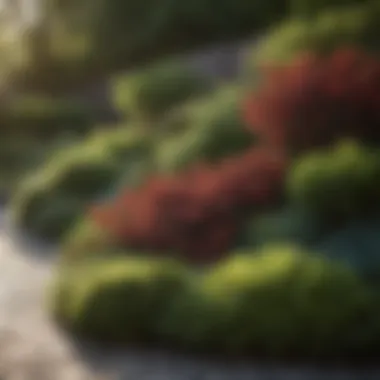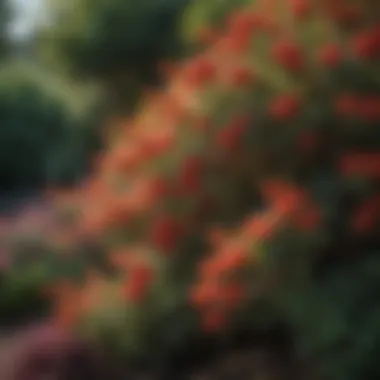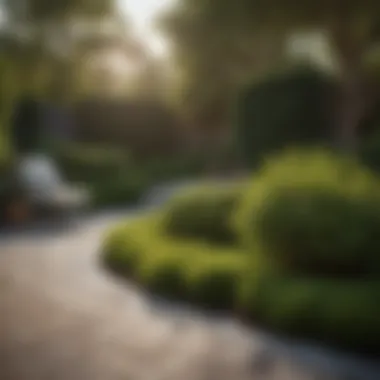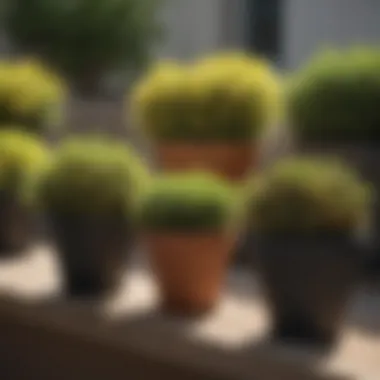Small Partial Sun Shrubs: Elevate Your Outdoor Elegance


Intro
The sophistication of outdoor spaces significantly relies on the selection of vegetation, particularly shrubs. Small partial sun shrubs offer a blend of beauty and practicality for gardens that do not receive abundant sunlight. Understanding their unique needs and how they complement a refined atmosphere can elevate the aesthetic of a property. This article dissects the captivating characteristics of these shrubs, guiding readers on how to effectively implement them into their outdoor spaces.
Outdoor Decor Ideas
Creating a visually striking outdoor area requires the right combination of elements. Small partial sun shrubs play a vital role in this endeavor, often serving as focal points beneath towering trees or along shaded pathways. These shrubs not only beautify but can also enhance other design aspects of outdoor spaces.
Seasonal Inspirations
When selecting small partial sun shrubs, consider foliage variations through different seasons. For instance, Hydrangea paniculata displays large blooms during summer that react beautifully with the sunlight filtering through nearby trees. In contrast, evergreen varieties can maintain a timeless appeal throughout the year.
Furniture Selection
Choosing outdoor furniture that complements soft shrubs is essential. For example, weather-treated teak or powder-coated aluminum furniture highlights the lush green foliage of shrubs without overpowering them. The sleek lines of contemporary design find harmony with natural elements, creating a tranquil outdoor space.
Decorative Lighting
The right lighting complements small partial sun shrubs beautifully. Use soft, warm lights to illuminate these plants, which will accentuate their colors in the evening. Think about strategic placements for solar path lights or discreet spotlights directed at the shrubs, creating a welcoming atmosphere with subtle elegance.
Plant Arrangements
Strategically arranged small partial sun shrubs can guide viewers through the garden. Plant in clusters to create texture and depth or as solitary accents in large pots to draw attention. Dueling fine foliage with diverse shrub heights enriches visual interest. For instance, pairing the low-growing Japanese painted fern with taller varieties such as Daphne odora results in contrasting layers.
Hardscaping Solutions
Incorporating stones or pavers reinforces visual structure within garden areas with partial sun. Designing walkways or walls aligned with these shrubs ties outdoor settings together. Using materials like gravel or natural stone gives vitality while leading visitors to various sections.
Sustainable Practices
Promoting ecological harmony in outdoor spaces is increasingly prominent. When selecting small partial sun shrubs, consider native species that require less water and provide habitat for local fauna. Practices such as mulching around shrubs conserve soil moisture and invest in sustainable gardening, aligning with luxury environmental ethics.
“Creating an outdoor space that is not just aesthetically pleasing but also complements native ecosystems is a hallmark of sophisticated design.”
Incorporating small partial sun shrubs thoughtfully addresses both visual impact and environmental responsibility. Taking a considered approach to these principles will undoubtedly enhance your outdoor experience while ensuring your choices align with a modern aesthetic perspective.
Prelims to Small Partial Sun Shrubs
The concept of small partial sun shrubs serves as a pivotal aspect in garden design, particularly in spaces that exhibit limitations concerning sunlight. Understanding these plants is essential for any designer or enthusiast who seeks to create a rich tapestry of greenery where full sun exposure may be lacking. They not only add layers of complexity and elegance to landscapes but also provide practical benefits, such as better use of space and enhancement of shaded areas, which are often overlooked.
Concept of Partial Sun
Partial sun conditions refer to areas that receive three to six hours of direct sunlight daily. In such conditions, plants adapted to these circumstances thrive. Small partial sun shrubs exhibit specific physiological traits allowing them to flourish in quenched light environments. This makes them particularly useful in shaded corners, beneath taller trees, or even beside buildings.
Their growth patterns and foliage are well-suited for these conditions, often displaying vibrant colors and textures that can easily transform an otherwise dull space into an eye-catching focal point. It is essential to assess which varieties are resilient and how to select them according the aesthetic goals any space aims to achieve.
Importance in Landscape Design
Small partial sun shrubs are critical to landscape design for situating elegance within confined landscapes. These plants serve various functional and aesthetic purposes. Key reasons include:
- Sustainability: Once established, these shrubs often demand less water and maintenance since they are suited for less-than-ideal lighting. They can thrive in washed out areas, making the entire garden more sustainable overall.
- Visual Appeal: The hues and forms of these shrubs contribute to visual richness. Pairing them correctly can deliver a sophisticated atmosphere that captures and enhances the garden’s beauty.
- Ecological Contribution: These plants provide habitat for various pollinators and birds. The benefit of promoting biodiversity extends beyond personal gardens, creating a harmonious ecosystem.
- Versatility: Small partial sun shrubs can fit harmoniously within differing themes of landscape design—be it modern minimalism or rustic charm.
Adopting these shrubs as point species in design fosters a deep connection to the surrounding environment, while their integration layered with strategic functions elevates the overall living environment.


Characteristics of Small Partial Sun Shrubs
The characteristics of small partial sun shrubs significantly contribute to their value in outdoor design. These shrubs exist in a niche where they thrive under limited sunlight while still providing aesthetic appeal and functional benefits. Proper understanding of these characteristics is essential when selecting plants that harmonize with surroundings, address space limitations, and meet design goals.
Size and Growth Habit
Small partial sun shrubs include varieties that typically range from two to five feet in height. Their compact size makes them ideal for various garden settings, including borders, patio spaces, and small gardens. When selecting these shrubs, consider their growth habit.
- Upright forms can serve as striking focal points or background features. For instance, Japanese Barberry has an elegant vertical profile.
- Mounded shapes, exemplified by Dwarf Furze, continue to grow outwards, adding fullness to the garden.
- Prostrate or spreading habits, as seen in Creeping Juniper, create ground cover with a nuanced texture.
The choice of style not only influences the aesthetic quality of a space but also incorporates functional elements such as privacy or wind protection. Shrubs with varied growth habits can establish visual layers, enhancing depth in design.
Leaf Structure and Color
Leaf structure and color significantly affect the vibrancy and health of small partial sun shrubs. Shrubs like Buxus sempervirens, commonly known as boxwood, show how dense foliage can offer a rich, green canvas for enhanced depth. Varieties exhibit diverse leaf structures, from broad and glossy leaves to needle-like forms, which can categorize the shrubs into different styles.
- Variegation also adds an extra visual element. Consider shrubs like Euonymus fortunei with their bright highlights that turn dull spaces into eye-catching areas.
- Seasonal color change can keep your garden dynamic. Many shrubs display color variations with seasons, ensuring constant visual interest throughout the year.
Selecting shrubs with contrasting foliage can create cycles of engagement that match changing light conditions, enriching the overall experience of an outdoor space.
Flowering Potential
The potential for flowering among small partial sun shrubs not only enhances beauty but also influences the ecosystem as a whole. While not all shrubs show remarkable blooms, several kinds offer distinctive flowers. Selecting shrubs like Weigela or Hydrangea can infuse limited light environments with flashes of color.
- Considering blooming periods is vital; some species bloom in early spring, while others maintain a summer flow.
- Hybrid varieties** often offer more extended bloom periods, adding assurance of color within typically quiet periods in gardens.
Blooms will attract pollinators, contributing significantly to local biodiversity and supporting ecological health in the environment. These flowers become vibrant focal points during prime growth periods, elevating aesthetic appeal and the experience as a whole.
Small partial sun shrubs can turn otherwise muted settings into sophisticated outdoor spaces, playing a crucial role in both aesthetics and ecological contribution.
Selecting Small Partial Sun Shrubs
Selecting the right small partial sun shrubs is crucial for crafting harmonious and visually appealing outdoor spaces. These plants add structure, color, and texture, enabling gardeners to maximize their aesthetic potential in shaded areas. The selection process requires careful consideration of various factors that affect growth and appearance, ensuring that the chosen shrubs complement both the environment and the overall design vision.
Evaluating Your Space
Before choosing specific shrubs, assessing the unique characteristics of your outdoor space is essential. Factors such as available sunlight, moisture levels, and existing landscape features play a vital role in selection. Observe how sun patterns change throughout the day and what areas receive only partial sunlight. The exact sun conditions guide you in selecting shrubs that thrive in these specific environments.
Additionally, consider the size of your space. Smaller gardens will require compact varieties that do not overcrowd the area. Larger spaces can accommodate more expansive growth. Recognizing the physical expectations helps ensure proper integration into your garden layout.
Tip: Map out your garden's dimensions first, then sketch potential shrub locations.
Understanding Soil Conditions
Another fundamental aspect of selecting small partial sun shrubs is understanding your soil's moisture and texture. Different shrubs have unique requirements regarding soil composition. For instance, some may thrive in well-drained sandy soils, while others might flourish in heavy clay. Testing soil pH can also provide insight necessary for shrub selection.
Soil amendments may be required based on the analysis. You might consider composting or specific fertilizers to achieve the ideal growing conditions. Balancing nutrient levels promotes robust and healthy plant development.
Matching Plants to Aesthetics
The shrubs you select should resonate with the overall design ethos of your outdoor area. Color, leaf shape, and seasonal changes impact the aesthetic experience. For example, a lush green shrub with light pink flowers can create a tranquil and rustic feel. In contrast, darker foliage with brilliant blossoms might project sophistication and boldness.
Consider revisiting your design palette. Identify existing colors in nearby elements such as furniture, pathway stones, or other plants. Your selected small shrubs should harmonize with these features, achieving a cohesive and appealing environment.


In summary, selecting small partial sun shrubs is not merely a transactional process. It requires a nuanced approach considering your landscape space, soil conditions, and aesthetic alignment. Executing these considerations thoughtfully allows for a sophisticated garden that captivates the attention while thriving in available conditions.
Maintenance of Small Partial Sun Shrubs
Caring for small partial sun shrubs involves several key areas that are fundamental to their thriving and aesthetic appeal. This sectiom covers critical points about watering, pruning, shaping, and fertilization, focusing on specific practices that ensure these plants not only survive but flourish in their designated partially shaded locales.
Watering Needs
Establishing a consistent watering routine is essential for small partial sun shrubs. While these plants are more tolerant of drought conditions compared to other types of greenery, they still require adequate moisture to maintain healthy growth. It's important to note that the frequency of watering should vary based on the shrub's needs and environment.
- Consider the mulch. A layer of organic mulch helps to retain soil moisture, regulate temperature, and suppress weeds.
- Check soil moisture regularly. Insert your finger a few inches into the soil. If it feels dry, it's time to water.
- Prefer deep soaking. This encourages roots to grow deeper into the soil and improves resilience against dry spells.
Over-watering may lead to root rot, so it's essential to strike a balance. In the autumn, adjust your watering practices, giving less frequency as the trees shed foliage and the cooler air reduces evaporation.
Tip: Use a soaker hose or drip irrigation to deliver consistent moisture directly to the roots.
Pruning and Shaping
Pruning is another significant task in keeping small partial sun shrubs in optimal health. It allows for not just the maintenance of aesthetic form but also improved air circulation and light penetration, which are crucial for shrub vitality.
When to prune:
- Early spring before new growth starts is an ideal time for most shrubs.
- Remove any dead, diseased, or crossing branches to promote new growth.
- Lightly shaping the shrub can hd strengthen its overall structure.
Method:
- Use sharp, clean tools to make precise cuts, minimizing stress on the plant. Pruning can also enhance flowering potential, especially in cultivars that bloom on new growth.
Ensure you also evaluate the shrub's shape during pruning. Consider creating a more rounded or pyramidal silhouette based on your design needs, reinforcing that careful shaping directly connects with visual appeal.
Fertilization Strategies
Integrating fertilization into your maintenance regimen can significantly enhance the health and vibrancy of small partial sun shrubs. Identifying the right nutrients and application duration not only improves plant vigor but also promotes blooming and foliage at the right time.
- Soil testing: Understand the nutrient content in your planting area. Testing can direct you on which type of fertilizer to use.
- Choose balanced products: A slow-release fertilizer high in nitrogen can benefit leafy shrubs while phosphorus and potassium encourage blooms.
- Timing is crucial: Fertilizer should be applied in early spring as the plant begins to actively grow. Consider a second application later in the summer if needed.
While maintaining small partial sun shrubs may demand efforts, focusing on these core areas—watering, pruning, and fertilization—creates a transformative outdoor space that showcases the elegance of careful design.
Design Techniques Using Small Partial Sun Shrubs
Design techniques for small partial sun shrubs are essential for creating a harmonious outdoor space in varied lighting situations. Utilizing these shrubs can not only address the unique requirements of light and growth but also interject elements of elegance into the landscape design. Shrubs, being versatile, allow planners and homeowners to integrate lush greenery and variety into shaded areas. By implementing effective design strategies, one ensures these shrubs contribute aesthetically while thriving in their catheterized light environments.
Creating Visual Layers
Creating visual layers is a foundational concept in landscaping. When small partial sun shrubs are placed in a tiered fashion, the result is not only visually appealing but functional. The idea here is to use shrubs of varying heights to guide the eye throughout the space. For example, larger shrubs can serve as focal points in the back, while smaller specimens fill the front.
Considerations include:
- The proportion of plants to their surrounding landscape.
- Use of color and leaf texture to create diverse focal points.
- Kind of partial sun exposure the shrub needs and how that suits with your garden's layout.
This layering creates depth. It countermands the flatness common in many traditional garden layouts. By designing with visual strata, these shrubs can indeed enhance sophistication in otherwise low-light conditions.
Combining with Other Plants


Effective pairing of small partial sun shrubs with other plants maximizes the benefits of all species involved. Optimizing the habitat sustains better soil health. Choosing companion plants that thrive in similar conditions ensures they will flourish together. Additionally, employing plants with contrasting colors or structural elements enriches the overall landscape composition.
Strategic combinations might involve:
- Low-growing groundcovers with tall shrubs for scale.
- Flowering plants that bloom in durations opposite to the shrubs, ensuring continuous visual interest.
- Evergreen plants mixed in for year-round appeal.
This design strategy not only enlivens shaded areas but broadens biodiversity, supporting a rich ecosystem.
The integration of diverse vegetation enhances resilience in the garden, contributing significantly to its overall aesthetic appeal.
Ultimately, employing thoughtful design techniques enables small partial sun shrubs to augment the sophistication of outdoor spaces without overshadowing their essential role. Using these approaches ensures both beauty and sustainability.
Benefits of Small Partial Sun Shrubs
Small partial sun shrubs offer a myriad of advantages that contribute significantly to outdoor spaces. Their ability to thrive in less than ideal lighting conditions makes them a practical choice for gardens where sunlight may be limited. Furthermore, these shrubs support biodiversity and contribute to ecosystem balance, which is pivotal for modern landscape design.
Biodiversity and Ecosystem Support
Incorporating small partial sun shrubs into garden designs encourages a diverse habitat for various wildlife species. These plants often serve as essential sources of food and shelter for pollinators like bees and butterflies. When considering plants for your garden, selecting small partial sun shrubs can foster an ecosystem that promotes biodiversity.
- Habitat creation: Small shrubs provide crucial spaces for wildlife to thrive. Birds and various insects utilize them for nesting and food sources.
- Sustainable practices: Choosing local varieties that are adapted to regional climates enhances resilience and reduces the need for chemical interventions. This approach supports overall environmental health.
- Pollinator support: Many small shrubs produce flowers that attract insects, which are vital for plant reproduction. Choosing such plants can help revive declining pollinator populations.
The integration of these shrubs can profoundly amplify an outdoor area's environmental quality. By selecting suitable native plants, you can bask in the beautiful coalescence of flora and fauna.
Year-Round Interest
Another appealing characteristic of small partial sun shrubs is their capacity to provide interest throughout all seasons. Gardens may often fall victim to monochromatic displays, especially during colder months. However, not with the right shrubs on display as they showcase dynamic visual qualities year-round.
- Winter Appeal: Some shrubs feature persistently vibrant berries or interesting bark structures, adding life to stark landscapes in winter.
- Spring Blooming: Numerous small shrubs exhibit dazzling blooms in early spring. Their flowers signal the turn of the seasons, setting a colorful tone that can invoke emotional responses.
- Summer Foliage: The lushness during summer offers plenty of visual variety. Some may change color throughout the season, enhancing your garden's dynamic character.
- Autumn Colors: As leaves begin to change, many small shrubs offer spectacular shades of red, orange, and yellow.
In summary, selecting appropriate small partial sun shrubs ensures beauty and simplifice maintenance throughout the year. They are not only practical but contribute significantly to creating inviting spaces that reflect seasonal changes in your landscape.
“The blending of functional ecology and aesthetic appeal through careful planting choices defines modern sustainable landscape designs.”
The End: Elevating Outdoor Spaces
The integration of small partial sun shrubs into outdoor spaces is not merely about aesthetics; it is also grounded in enhancing the overall ecological health and sustainability of the landscape. These shrubs possess a unique set of characteristics that enable them to thrive in limited sunlight while adding intricate layers to garden design. Their adaptability opens a realm of opportunities for creating sophisticated, living spaces that hold both beauty and functionality.
Incorporating small partial sun shrubs can yield various benefits, particularly for those with aesthetics in mind. The careful selection and placement of these plants allow for the establishment of visual focal points in otherwise shady areas. Tasks of customizing the integration of these shrubs can vary but often involve grouping them in a way that emphasizes their growth habits and colors. Familiarization with the specific light and soil conditions of the property guides this process effectively, ensuring a successful aesthetic outcome.
Small partial sun shrubs do not only beautify space—they support biodiversity, attract pollinators, and contribute to the health of the environment.
Moreover, small shrubs lend year-round interest with their leaves, blooms, and potential berries. As seasons shift, these plants redefine the outdoor environment, making it dynamic and captivating. Understanding trends in landscape design emphasizes the importance of using indigenous species whenever possible. This approach generates a sense of incognito perfection that complements natural elegance, enhancing sophistication.
Integrating Small Shrubs Into Design
Successfully integrating small partial sun shrubs into design requires careful thought. Emphatic attention to spatial relationships among plants is crucial to create an inviting garden scale. Ambiguity in plant selection can lead to cluttered and unappealing arrangements. Understanding the from of each shrub provides clarity when planning and designing spaces.
Key elements to consider:
- Scale: Choose shrubs based on size in context to surrounding features.
- Color Pallete: Match seasonal color blooms to enhance peak visual interest.
- Textural Depth: Plants vary in leaf shape and texture—leveraging these differences yields layers.
The arrangement should be done in tiers, combining taller plants positioned in the background, mid-height shrubs in the middle, and smaller specimens up front. This composition fosters both unity and diversity. An architecturally designed landscape may further appreciate the incorporation of small partial sun shrubs alongside ornamental grasses, perennials, and ground covers that thrive under planted design principles. Layout choices guide the harmony of plants interweaving into ecosystems that flourish in accordance to their site requirements.
Final Thoughts on Sustainability
Sustainable practices lead to long-term environmental goals, defined by their relationship with upkeeping and nurturing small partial sun shrubs. Comprehending sustainable gardening principles transforms one's garden into a meaningful ecosystem. Actions such as planting in adherence to local flora successfully encourage remaining wildlife, particularly essential pollinators.
Investing energy and resources into these naturistic practices expands beyond mere gardening—it conforms to the global agenda of biodiversity preservation. Knowing how specific shrubs sustain themselves can reduce reliance on chemical treatments. Additionally, accessible mulch layers provide insulation and moisture gardening benefits, lowering the need for supplemental watering.
By establishing a mindfully curated garden with small partial sun shrubs, designers, botanists, and laymen alike create impactful spaces that mirror the environment, thus planting the bulbs of change for sustainable practices. Embracing the nuances of choosing the appropriate species guides conscientious stewardship of the landscape and fosters tranquility cultivating successful and serene environments.







